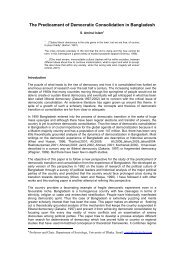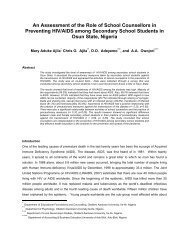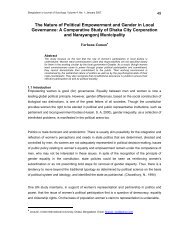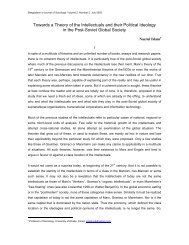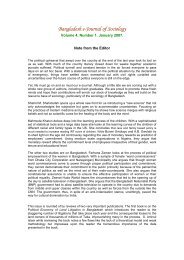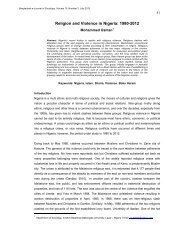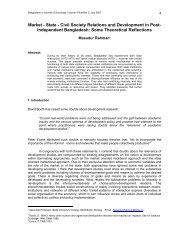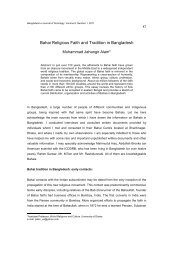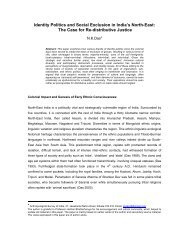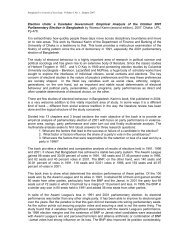Bangladesh e-Journal of Sociology - Bangladeshsociology.org
Bangladesh e-Journal of Sociology - Bangladeshsociology.org
Bangladesh e-Journal of Sociology - Bangladeshsociology.org
Create successful ePaper yourself
Turn your PDF publications into a flip-book with our unique Google optimized e-Paper software.
<strong>Bangladesh</strong> e-<strong>Journal</strong> <strong>of</strong> <strong>Sociology</strong>. Volume 6, Number 1. 2009.<br />
36<br />
acceptable. Kline (2005) mentions that the acceptable ratio <strong>of</strong> the number <strong>of</strong> cases to the number<br />
<strong>of</strong> free parameters is 10:1. In the present study, this ratio for each <strong>of</strong> the models (initial, respecified,<br />
and final) is within this range, and therefore, our sample size is acceptable. We<br />
recognize, however, that the larger sample size is always helpful for better generalization. Our<br />
sample size is non-random, which is more likely to hold back generalizability. Lastly, following the<br />
rationale <strong>of</strong> Higgins and Ricketts (2004), we argue that the generalization on any survey data<br />
should be considered in relative terms.<br />
Technique <strong>of</strong> analysis:<br />
We use Structural Equation Modeling (SEM) to test our hypotheses. The measurement part <strong>of</strong><br />
our model has used Confirmatory Factor Analysis (CFA), because theoretically, the variables we<br />
have depicted in Figure 1 are actually latent in combinations <strong>of</strong> some beliefs. Therefore, the usual<br />
path analysis cannot be used to measure these latent constructs. Moreover, the use <strong>of</strong> CFA<br />
examines the construct validity <strong>of</strong> our measurements. The structural part <strong>of</strong> the model estimates<br />
the effects <strong>of</strong> the independent latent constructs on the dependent latent ones. For this part, we<br />
use Maximum Likelihood method, because this method “maximizes the likelihood <strong>of</strong> a sample<br />
that is actually observed” (Kline 2005:112). In most SEM research, this is the most popular<br />
method <strong>of</strong> analyzing data.<br />
However, the first condition to do maximum likelihood is to confirm the normalcy <strong>of</strong> data.<br />
Following the guidelines <strong>of</strong> Kline (2005), we checked this, and found that the skew index is below<br />
3, and the kurtosis is below 8 for each variable. Thus, our data in the analysis are normal, and<br />
also, we do not have any outliers.<br />
Measures:<br />
We mentioned earlier that we need to assess latent constructs based on observed indicators for<br />
the present study. Let us elaborate these latent constructs and their corresponding observed<br />
indicators.<br />
(1) Socio-economic Status (SES) <strong>of</strong> men: Our first three hypotheses outline the effects<br />
<strong>of</strong> men’s socio-economic status on their beliefs about sexuality and rape myths as well as on their<br />
exploration <strong>of</strong> multiple sex partners. As we argue, one’s socioeconomic status is associated with<br />
one’s progressive or conservative views about sexuality and rape myths while access to<br />
resources creates avenues for men to explore multiple sex partners, and thus men enjoy the<br />
privileges in society. The access to resources in society can be determined by one’s education<br />
and occupational status. Instead <strong>of</strong> taking income as one <strong>of</strong> the variables, we opt for occupational<br />
status, which counts on both income and status. Therefore, the most acceptable measure for<br />
Socio-economic status (SES) is comprised <strong>of</strong> two variables: occupational status and education.



